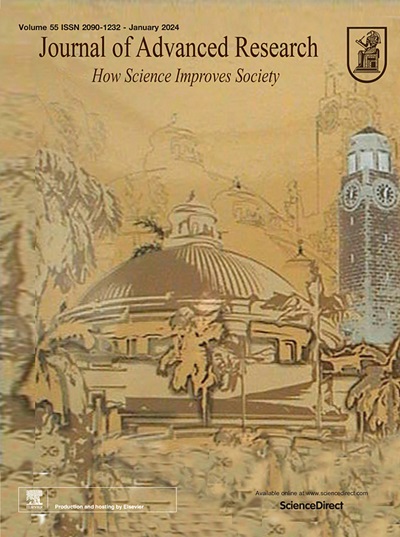通过抑制咖啡酸o -甲基转移酶的木质素修饰的功能级联,用于水稻的生物生产和抗氧化
IF 13
1区 综合性期刊
Q1 MULTIDISCIPLINARY SCIENCES
引用次数: 0
摘要
作物秸秆提供了大量生物质资源,可转化为可持续生物燃料和有价值的生物产品。然而,天然木质纤维素的顽固性导致了昂贵的生物质过程和二次废物的释放。由于木质素是一种主要的顽固性因子,木质素生物合成的基因工程越来越多地应用于生物能源作物,但对所需的木质素纤维素改造及其功能仍不清楚。目的探讨木质素修饰在体外有效转化木质纤维素和体内有效的植物抗氧化反应的机制。方法利用参与单脂醇(G, S)和阿魏酸(FA)合成途径的咖啡酸o -甲基转移酶(cafic acid O-methyltransferase)进行现代CRISPR/cas9编辑,筛选特异性水稻突变体,然后利用先进的化学、生化和热化学分析探索木质纤维素转化和植物镉(Cd)积累。结果3个突变体主要通过协同下调s单体合成实现了显著的木质素修饰。因此,木质纤维素孔隙率提高了1.8倍,与野生型相比,生物质糖化和生物乙醇产量显著提高了20 %-26 %。改性后的木质素也有利于各种木质素纳米颗粒的解剖,其尺寸减小了1.5-1.9倍,适用于热化学转化为碳量子点,产率分别提高了15 %和31 %。突变体的g -单体和FA的比例显著增加,并且木质素提取物的两种标准抗氧化剂(DPPH和ABTS)的体外活性比野生型高,表明突变体的植物抗氧化能力明显增强。水培养结果表明,突变苗积累的Cd比野生型多(p <; 0.01,n = 3),表明突变体对重金属有有效的植物修复作用。结论提出了一种木质素特异性s单体还原的假设模型,该模型可以改善木质纤维素的抗逆性。它为实现高产量生物燃料和高附加值生物产品或提高植物抗氧化能力提供了强有力的策略。本文章由计算机程序翻译,如有差异,请以英文原文为准。

A functional cascading of lignin modification via repression of caffeic acid O-methyltransferase for bioproduction and anti-oxidation in rice
Introduction
Crop straws provide substantial biomass resources that are transformable for sustainable biofuels and valuable bioproducts. However, the natural lignocellulose recalcitrance results in an expensive biomass process and secondary waste liberation. As lignin is a major recalcitrant factor, genetic engineering of lignin biosynthesis is increasingly being implemented in bioenergy crops, but much remains unclear about the desired lignocellulose alteration and resulting function.Objectives
This study attempted to explore the mechanisms of lignin modification responsible for efficient lignocellulose conversion in vitro and an effective plant anti-oxidation response in vivo.Methods
We initially selected specific rice mutants by performing modern CRISPR/cas9 editing with caffeic acid O-methyltransferase involved in the synthetic pathways of monolignols (G, S) and ferulic acid (FA), and then explored lignocellulose conversion and plant cadmium (Cd) accumulation using advanced chemical, biochemical and thermal-chemical analyses.Results
Notable lignin modification was achieved from the predominately synergistic down-regulation of S-monomer synthesis in three mutants. This consequently upgraded lignocellulose porosity by up to 1.8 folds to account for significantly enhanced biomass saccharification and bioethanol production by 20 %-26 % relative to the wild-type. The modified lignin also favors the dissection of diverse lignin nanoparticles with dimensions reduced by 1.5–1.9 folds, applicable for thermal-chemical conversion into the carbon quantum dots with increased yields by 15 % and 31 %. The proportions of G-monomers and FA were significantly increased in the mutants, and the lignin extractions were further assayed with higher activities for two standard antioxidants (DPPH and ABTS) in vitro compared to the wild-type, revealing a distinctively enhanced plant antioxidative capacity in the mutants. Water culture showed that young mutant seedlings accumulated more Cd than wild-type did (p < 0.01, n = 3), suggesting effective heavy metal phytoremediation in the mutants.Conclusion
A hypothetical model of characteristic lignin modification for specific S-monomer reduction, accountable for improved lignocellulose recalcitrance, was proposed. It provides a powerful strategy for achieving high-yield biofuels and value-added bioproducts or enhancing plant antioxidative capacity for heavy metal phytoremediation.求助全文
通过发布文献求助,成功后即可免费获取论文全文。
去求助
来源期刊

Journal of Advanced Research
Multidisciplinary-Multidisciplinary
CiteScore
21.60
自引率
0.90%
发文量
280
审稿时长
12 weeks
期刊介绍:
Journal of Advanced Research (J. Adv. Res.) is an applied/natural sciences, peer-reviewed journal that focuses on interdisciplinary research. The journal aims to contribute to applied research and knowledge worldwide through the publication of original and high-quality research articles in the fields of Medicine, Pharmaceutical Sciences, Dentistry, Physical Therapy, Veterinary Medicine, and Basic and Biological Sciences.
The following abstracting and indexing services cover the Journal of Advanced Research: PubMed/Medline, Essential Science Indicators, Web of Science, Scopus, PubMed Central, PubMed, Science Citation Index Expanded, Directory of Open Access Journals (DOAJ), and INSPEC.
 求助内容:
求助内容: 应助结果提醒方式:
应助结果提醒方式:


